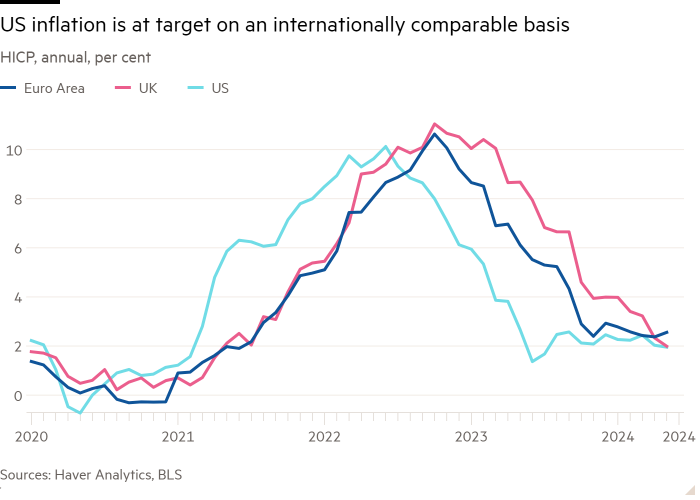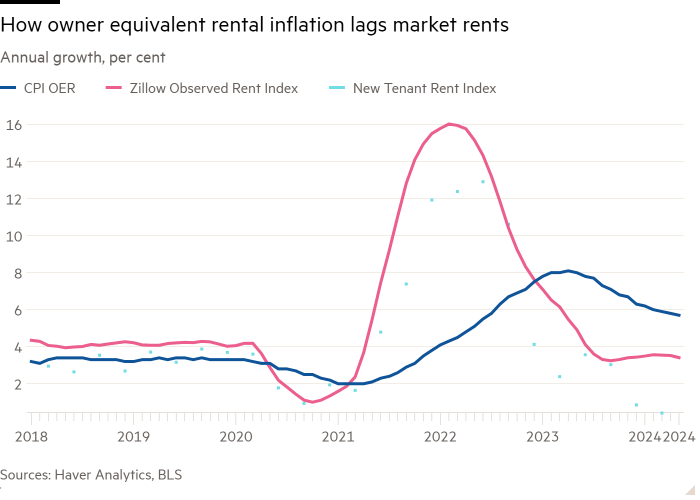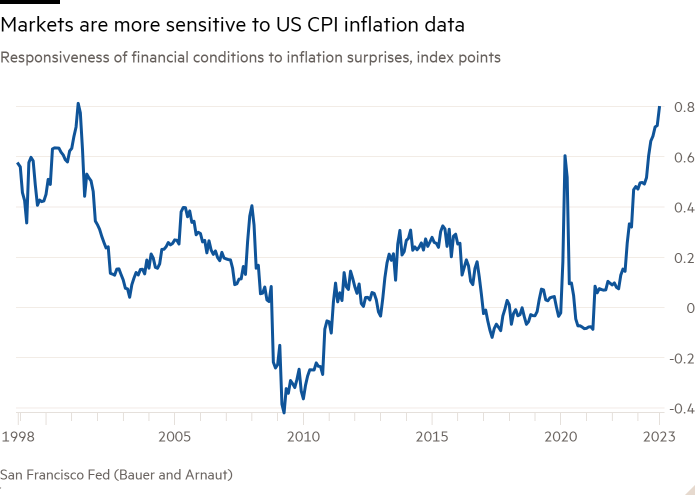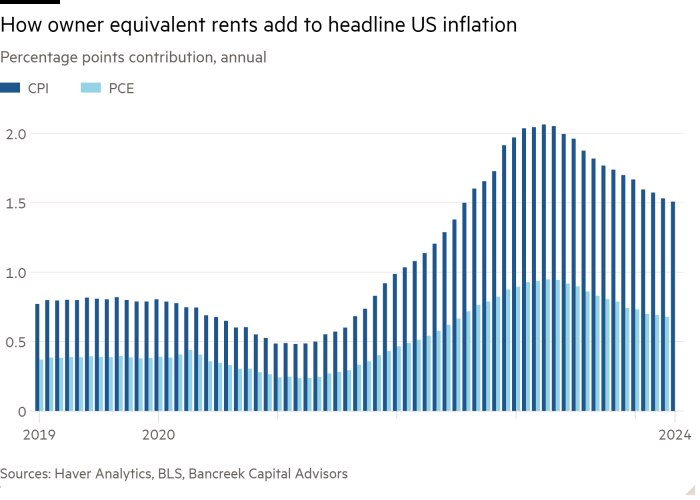Why the Fed must change how it targets inflation

Simply sign up to the US inflation myFT Digest -- delivered directly to your inbox.
The US Federal Reserve’s influence on global capital flows, asset prices, and currencies dwarfs any other monetary policymaker. That’s why its interest rate-setting framework matters more than most.
This cycle has, however, highlighted a few flaws in the Fed’s approach. So, ahead of its inevitable post-cycle postmortem, FT Alphaville wanted to lay out some considerations for reform.
First, a refresher:
- In America, financial markets and politicians focus on the Consumer Price Index. That is because things like inflation-indexed bonds and Social Security payments are linked to it. The Fed, however, targets 2 per cent annual growth in the Personal Consumption Expenditure measure.
- The Fed switched to focusing on PCE inflation in 1996 under then Chair Alan Greenspan, after a commission had found that CPI had overstated inflation by an average of 1.1 percentage points per year. (More on PCE vs CPI, here.)
- Both include a measure for owner-occupied housing costs, a proxy for how much homeowners would pay for the shelter of their home, known as “owner equivalent rents”. It accounts for over one-third of core CPI, and is also included in the PCE, with a lower weighting. It’s an imputed measure, estimated using comparable rents.
- In Europe attention is narrowed upon a single inflation number, the internationally recognised Harmonised Index of Consumer Prices (though there are differences). This excludes owner-equivalent costs entirely, although Britain and the Eurozone still track it in auxiliary indices. Based on HICP, American inflation is running below the Eurozone and Britain — and below target.

So what’s the problem? FTAV reckons there are three.
First is the inclusion of a dubious estimate of OER in US CPI and PCE. “The problem with OER is that it is a price that no one actually pays,” says Paul Donovan, chief economist at UBS Global Wealth Management. He notes three particular problems with how it’s estimated:
“The US rental market is small. That means small changes in demand for rental property will change market rents — which should be captured in CPI — but these will then be magnified as the rental changes are used to calculate OER.” Indeed, the rental equivalent approach is problematic when the cost of homeowning (most Americans are on lower, locked-in fixed rates or don’t have a mortgage) diverges from rents (which have soared).
“The rents used to calculate OER are measured by a survey of just 7,800 housing units, and the response rate has fallen from nearly 70 per cent ten years ago to 56.5 per cent.”
“The universe of properties available to rent is unlikely to match the universe of properties available to buy, especially in a specific neighbourhood, requiring a lot of guesswork.”
So, calculating OER involves a lot of conjecture. That is not unique; several components of the CPI and PCE are estimated in odd ways. The problem is OER’s strong weighting.
OER also lags market rents. It’s estimated using both existing rental contracts and new ones. Fair. Not everyone’s rent rises at the same time. But, right now OER is central to the headline stickiness in US inflation, and therefore Fed policy. That is partly because it still reflects the lagged surge in rents that came in the aftermath of the pandemic.
Chair Jay Powell knows this. At June’s post-Fed meeting press conference, he said “it may take several years” for pandemic-era rent increases to work their way into the CPI.

OER is not the only factor influencing Fed rates. But most price pressures are generally on a downward trend, and OER should also pull down, as per its lag. Taking into account the lags in how interest rates cuts also hit the economy, Powell has previously reiterated that the Fed will need to cut rates before the 2 per cent target is reached. So why isn’t he cutting? (There are plenty of other lagging components in the indices, which give a false impression of underlying inflation today).
It’s possible that his touting of “data dependency” may have trapped him. This cycle has been characterised by an almost Pavlovian market response to CPI prints. If data comes in above expectations, markets price out and push back the cutting cycle, thereby raising the stakes for the Fed to go against the market.

But that binary analysis overlooks the reasons for why expectations were not met, or why inflation remains sticky. And as FTAV has previously shown, a lot of the stickiness is driven by the flawed inclusion of OER.
That leads us nicely to the second flaw: Two main measures add to confusion and volatility.
With its two-week release ahead of the PCE, the CPI has remained an important leading trading point for investors seeking to position early on rates. As the CPI and PCE have tended to move together, this has not been a problem.
But, right now the wedge between the two has grown to a multiyear high, which makes the read across difficult. The main differences come down to their coverage, weights, and formulas. The lack of clarity on what inflation actually is, has become a recipe for skittish market pricing. (A considerable part of that comes from the weighting differences given to OER).

“One of Powell’s several policy errors was that he elevated the importance of CPI as a measure back in mid 2022,” says Donovan. “Having done so, it is difficult to be cutting rates when headline CPI is above 3 per cent.” Both cannot fit into a 2 per cent price target framework.
Third, is the risk of measurement-led divergence in rate cycles between the US and Europe.
There are a number of differences between US CPI and PCE and the Eurozone HICP and UK CPI. Different countries’ consumers buy different things — baskets, weights and even tax treatments are different. That means there will always be some element of apples and oranges when comparing cross-border inflation measures.
“I think it is a plus if global central banks are targeting similar inflation measures,” says Mark Zandi, chief economist and Moody’s Analytics, “thus reducing potential divergences in monetary policy due simply to measurement differences.”
But in cycles when elements of those differences are exacerbated, in this case by housing and rental shortages driven by the pandemic, they can become drivers of divergence in rate policy. In that case, a statistical quirk can in theory determine real economic variables such as exchange rates and capital flows.

Since the major central banks target 2 per cent inflation, if one measure gets psychologically closer to that number, it impacts market and policy actions (over and above the actual inflation dynamics). Indeed, the ECB has already made its first cut, and the BoE is contemplating it.
Research by Christopher Cotton, an economist at Boston Fed, underscores that dynamic. He assessed the implication of lagged market rents feeding into the headline US CPI component.
“I estimate that from June 2024 to June 2025, based on the current difference between market rent and CPI shelter and the pace at which the two converge in the post-pandemic period, CPI shelter will grow 1.6 percentage points more than it would if there were no such gap,” he notes. As rents feed in OER too, it adds to the Fed’s challenge of returning inflation to 2 per cent.
Zandi has even argued that high interest rates have made new house building difficult and homeowners reluctant to give up lower locked-in rates by selling their homes. That then raises the cost of renting, which boosts inflation, and then creates a motive to keep rates higher for longer . . .
So, what are the solutions?
First, some caveats. Rethinking how the Fed targets its inflation goal is not about shifting the goalposts to suit its agenda. It’s a matter of sound interest rate setting, after the problems highlighted by this cycle above.
Second, no inflation measure is perfect. The exclusion of OER in the Europe headline measures does not make it better. A home provides a service (shelter), and that should be included in consumer prices, as it impacts standards of living. The debate is around how it’s approximated.
Third, changing tact on monetary policy mid-cycle is a recipe for losing credibility. So, these are options the Fed should mostly contemplate after this cycle.
- A better communication strategy: A central banker saying they are “data dependent” is a bit like a taste tester saying they will be led by taste. What matters are the specifics, and how things are communicated. Rather than encouraging an unrelenting static focus on how far CPI or PCE is from 2 per cent, the Fed needs to encourage a dynamic, forward-looking approach. That means articulating how it sees certain measures and lagged components evolving, and what it is and isn’t willing to “look through”.
“I think that the Fed should very explicitly say that understanding something as complex as inflation in somewhere as complex as the US economy requires a range of measures and sub measures,” says Donovan. So, still data-dependent but a broader conversation that does not attempt to give the market (or journalists) a yes/no answer, but focuses on trends.
- A clearer primary focus: Powell has made clear that the Fed targets PCE, but could do more to de-emphasise CPI, or at least clarify how the central bank treats developments in CPI. “The CPI is designed to track the cost of living, its primary use is to index things like social security payments. It isn’t primarily designed to be a monetary policy tool” says Paul Ashworth, chief North America economist at Capital Economics.
- Remove OER from the headline measure: A radical option is for the US to shift entirely to the internationally recognised HICP methodology. That may boost comparability, but HICP is not without its flaws — plus US CPI, which is closer to HICP, is not what the Fed wants to focus on. So, while question marks remain over the measure of OER, perhaps the Fed ought to focus on targeting PCE ex OER. OER can meanwhile continue to be monitored, as it is in Europe.
- Improving the OER measure: Clearly the OER methodology could do with investment. It’s worth developing a better understanding of how to survey and approximate owner-equivalent costs (perhaps in collaboration with international central banks) before returning to a decision of reincorporating it into the headline measure. (Fixing various other quirks is important too).
The last proper review of how the US measures inflation was in the Greenspan era in the 1990s. It’s certainly time for another one. And it’s worth doing it before any broader review on the validity of a 2 per cent target. But even more important than any particular inflation measure or target is fixing how the Fed actually goes about communicating and calibrating its response.
Comments